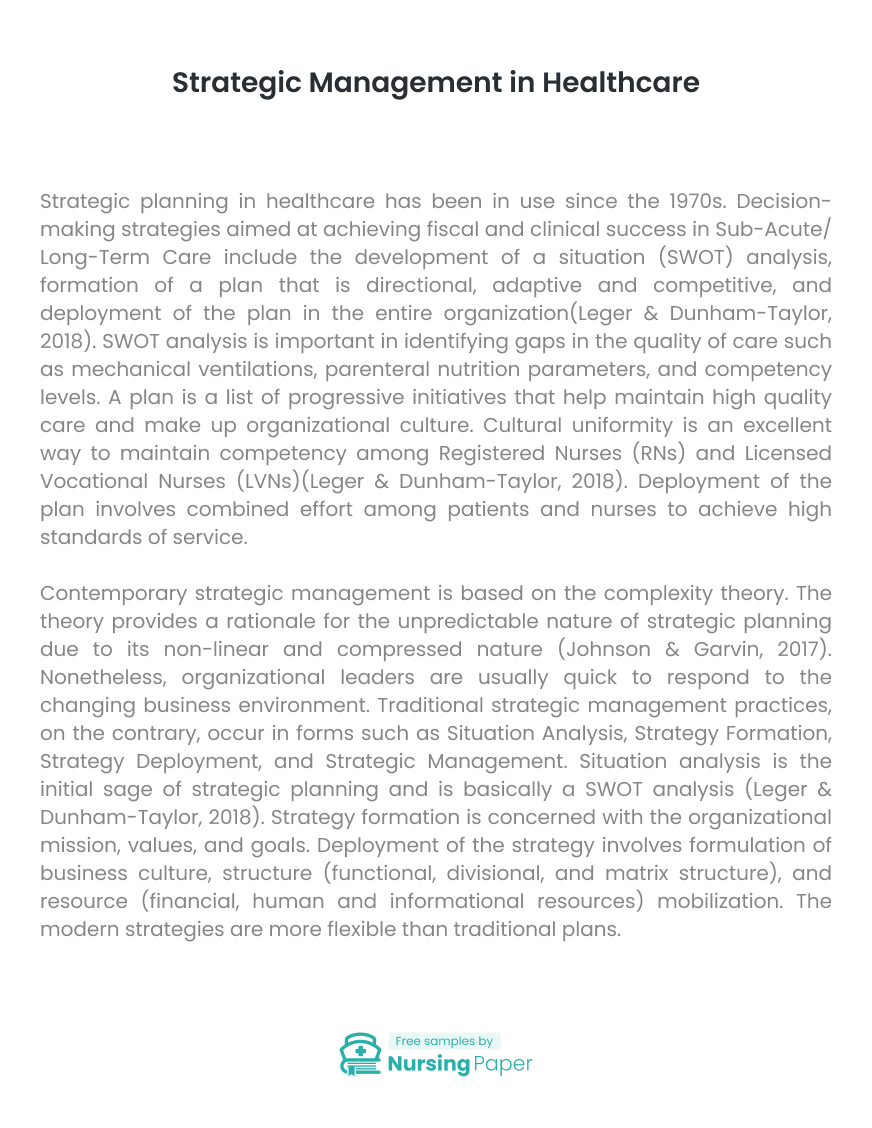
Strategic Management in Healthcare
Introduction
Strategic planning in healthcare has been in use since the 1970s. Decision-making strategies aimed at achieving fiscal and clinical success in Sub-Acute/Long-Term Care include the development of a situation (SWOT) analysis, formation of a plan that is directional, adaptive and competitive, and deployment of the plan in the entire organization(Leger & Dunham-Taylor, 2018). SWOT analysis is important in identifying gaps in the quality of care such as mechanical ventilations, parenteral nutrition parameters, and competency levels. A plan is a list of progressive initiatives that help maintain high quality care and make up organizational culture. Cultural uniformity is an excellent way to maintain competency among Registered Nurses (RNs) and Licensed Vocational Nurses (LVNs)(Leger & Dunham-Taylor, 2018). Deployment of the plan involves combined effort among patients and nurses to achieve high standards of service.
Contemporary strategic management is based on the complexity theory. The theory provides a rationale for the unpredictable nature of strategic planning due to its non-linear and compressed nature (Johnson & Garvin, 2017). Nonetheless, organizational leaders are usually quick to respond to the changing business environment. Traditional strategic management practices, on the contrary, occur in forms such as Situation Analysis, Strategy Formation, Strategy Deployment, and Strategic Management. Situation analysis is the initial sage of strategic planning and is basically a SWOT analysis (Leger & Dunham-Taylor, 2018). Strategy formation is concerned with the organizational mission, values, and goals. Deployment of the strategy involves formulation of business culture, structure (functional, divisional, and matrix structure), and resource (financial, human and informational resources) mobilization. The modern strategies are more flexible than traditional plans.


External environment analysis entails opportunities and threats whereas the internal environment is the aggregate strengths and weaknesses of an organization(Johnson & Garvin, 2017). Failure to analyze business opportunities can potentially lead to retarded progression as the business is likely to stick to old fashioned ways of operation. Ignoring possible threats adds up to ill preparation for emergency situations. The failure to evaluate business weaknesses would create confusion regarding which areas need improvement. Lack of knowledge about organizational strengths can potentially lead the managers into doing away with health healthcare practices.
A balanced scorecard (BSC) refers to a strategic management planning system used in an organizational setting to communicate goals, align daily work with strategy, prioritize projects, and measure progress towards company targets(Johnson & Garvin, 2017). Effective measures for sub-acute care with regard to a BSC include routine cleaning of equipment such as feeding tubes, predetermining physical, occupational and speech therapy techniques, proper sanitation of inhalation instruments, and predetermining daily minimum nursing hours per patient. Based on existing policies, patients require 3.8 hours of actual nursing, 2.0 actual CNA (Certified Nurse Assistant) hours and daily in Free Standing Nursing Facilities(NFs) while in Distinct-Part NFs, the limit for LNs is 4hous and 2hours for CNAs(Holloway & Galvin, 2016). In addition, the organization must predetermine minimum qualifications of potential staff members to ensure that the scorecard is well maintained. Existing policies
Qualitative techniques involve the collection, organization and analysis of a bulk of texts from talks and observations (Holloway & Galvin, 2016). The observation-based method of qualitative analysis is best suited for financial analyses. The observation technique is a systematic checking of various factors including studying quality issues(Holloway & Galvin, 2016). Observation techniques can help improve fiscal management whereby outstanding financial records can help adopt improved budgeting techniques. Budgeting enables to determine appropriate medical costs for sub-acute care techniques. Observation is also important in identifying patient technical needs and balances the same with professional capacities. In so doing, salary extents are easily determined.

1. Holloway, I., & Galvin, K. (2016). Qualitative research in nursing and healthcare.John Wiley & Sons.
2. Johnson, J. E. & Garvin, W. S. (2017). Advanced Practice Nurses: Developing a Business Plan for an Independent Ambulatory Clinical Practice. Journal of Nursing Economics.June 2017/Vol. 35/No. 3
3. Leger, J. M. & Dunham-Taylor, J. (2018). Financial Management for Nurse Managers: Merging the Heart with the Dollar. www.joblearning.com



The download will start shortly.

The download will start shortly.
 Subject:
Medicine
Subject:
Medicine  Number of pages: 6
Number of pages: 6  Subject:
Nursing
Subject:
Nursing  Number of pages: 4
Number of pages: 4  Subject:
Nursing
Subject:
Nursing  Number of pages: 2
Number of pages: 2  Subject:
Medicine
Subject:
Medicine  Number of pages: 3
Number of pages: 3  Subject:
Nursing
Subject:
Nursing  Number of pages: 2
Number of pages: 2  Subject:
Medicine
Subject:
Medicine  Number of pages: 11
Number of pages: 11  Subject:
Health and Social Care
Subject:
Health and Social Care  Number of pages: 3
Number of pages: 3  Subject:
Health and Social Care
Subject:
Health and Social Care  Number of pages: 4
Number of pages: 4  Subject:
Health and Social Care
Subject:
Health and Social Care  Number of pages: 2
Number of pages: 2  Subject:
Medicine
Subject:
Medicine  Number of pages: 7
Number of pages: 7  Subject:
Health and Social Care
Subject:
Health and Social Care  Number of pages: 3
Number of pages: 3  Subject:
Health and Social Care
Subject:
Health and Social Care  Number of pages: 6
Number of pages: 6  Subject:
Health and Social Care
Subject:
Health and Social Care  Number of pages: 3
Number of pages: 3  Subject:
Nursing
Subject:
Nursing  Number of pages: 2
Number of pages: 2  Subject:
Medicine
Subject:
Medicine  Number of pages: 2
Number of pages: 2 
